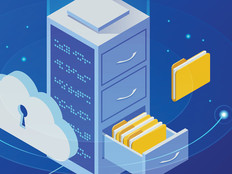Schools View Cloud Infrastructure as a Viable Option
With his IT headquarters based in an old mobile-home factory, Rob Curnow of the Central Valley School District in Spokane Valley, Wash., knew he couldn’t afford an internal upgrade of the district’s infrastructure.
“When we looked into an upgrade, it was going to cost nearly $140,000 just to get the server room updated,” says Curnow, the district’s technology services supervisor.
Instead, two years ago the school district turned to a service provider that offers the VMware vCloud Hybrid Service. For a significantly reduced annual cost, Central Valley School District has the server, storage and network capacity it needs to support the data and video requirements of a modern school district. “We can also now move forward building out our wireless infrastructure and look to support students and teachers bringing their own devices to school,” Curnow says.
The cloud service enables the district to leverage the expertise of the service provider. For example, there’s always someone available to service the cloud infrastructure; and, Curnow points out, the district does not need to train staff in cloud and virtualization skills. “They also have 10 redundant Internet links that sit behind two firewalls — there’s just no way I could have recreated that kind of infrastructure,” he adds.
For now, the district still maintains some IT functions in-house, such as test servers, domain controllers and security cameras. “We’ll analyze a request from one of the departments or a faculty member, and if it makes economic sense to run the service with the vendor in the cloud, we’ll do it that way,” Curnow explains. “We still have one server administrator, but he can’t manage 50 servers by himself.”
Wayne Pauley, a senior analyst for the Enterprise Strategy Group, says many IT organizations turn to the cloud because they no longer want to be in the infrastructure business. “For many organizations, it used to take six months to budget, procure and acquire information technology,” he says. Shrinking that process to a few days brings a strong advantage to any organization, allowing IT to focus on customer service and adding new capabilities.
90% The percentage of organizations that are either spending or planning to spend some part of their IT budget on cloud services
SOURCE: “Cloud Service Providers: Assessing Which IaaS Provider Fits Best” (Enterprise Strategy Group, July 2013)
Future Thinking
In three to five years, much of California’s Fresno Unified School District’s centralized technology infrastructure will run in the cloud.
“We see cloud computing as a gradual migration,” says Chief Technology Officer Kurt Madden. The district uses Microsoft Office 365 over Microsoft Windows Azure, and Madden says that Windows 8 is more cloud-friendly than previous operating systems. “For example, when you open Windows Explorer within Windows 8, all the cloud-based Microsoft SkyDrive files will show.”
Madden says as cloud technology matures and prices come down, the school district won’t want to maintain all its technology infrastructure internally. “I think we would want to focus on more strategic systems, like dashboards, the student information system, human resources and financial applications. But even they may run in the cloud at some point, ” he says.
Sorting Out the Cloud
Wayne Pauley, senior analyst for the Enterprise Strategy Group, points out that the array of service provider types can be confusing because some got their start by providing colocation or managed services. Here’s how ESG distinguishes among the different types of providers:
- Colocation providers (COLOs) usually own the physical plant, which includes the data center, the building, the power and cooling infrastructure, the core network, and often the physical security cages for each customer’s system. Customers are usually responsible for providing all of their own equipment and implementing it. This includes storage, network gear, servers and backup technology. Customers are offered a choice of the IP ranges that the colocation provider has available or a pipe to their own ISP provider.
- Managed service providers (MSPs) offer services across many different business functions, including human resources and enterprise resource planning. Most MSPs deliver some level of management for the infrastructure stack, which can include backup and recovery and security services. The customer still usually owns the hardware or leases it from the MSP.
- Cloud services providers (CSPs), or more accurately, public-cloud service providers, offer Infrastructure as a Service (IaaS), Platform as a Service (PaaS) and/or Software as a Service (SaaS). In all of these cases, the provider owns the facility and provides and manages the back-end infrastructure. To offer these services, a CSP must meet the definition of a cloud provider set forth by the National Institute of Standards and Technology, which includes five key tenets: on-demand/self-service, broad network access, resource pooling, rapid elasticity and measured services.








